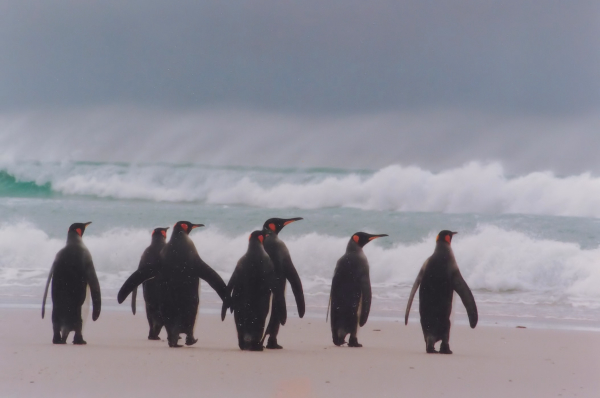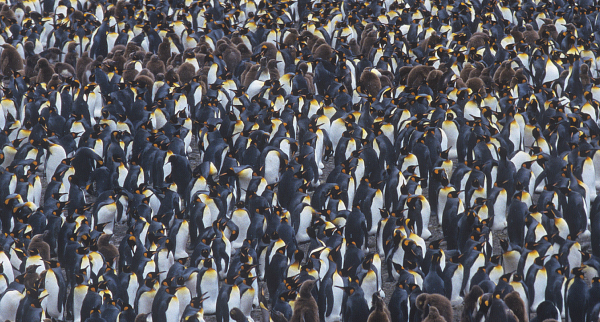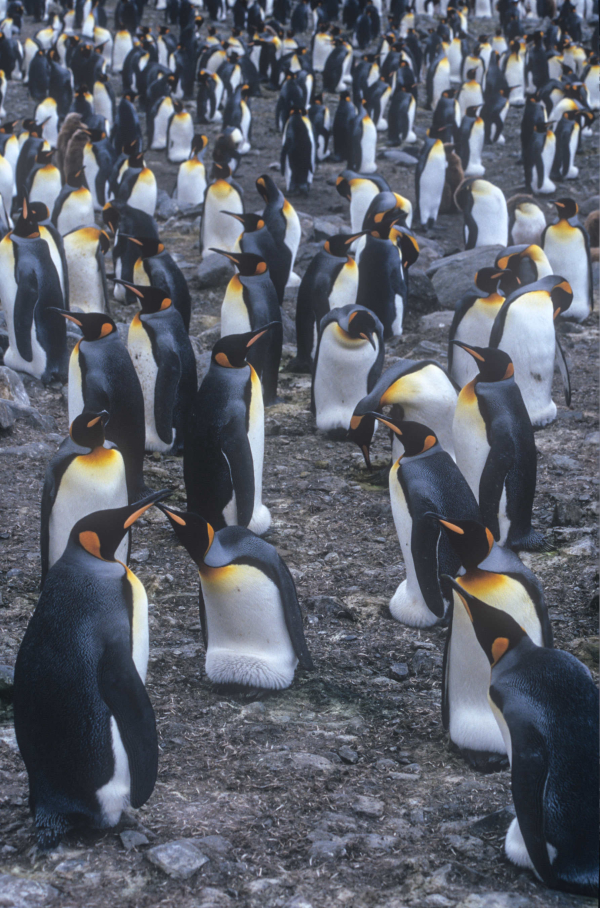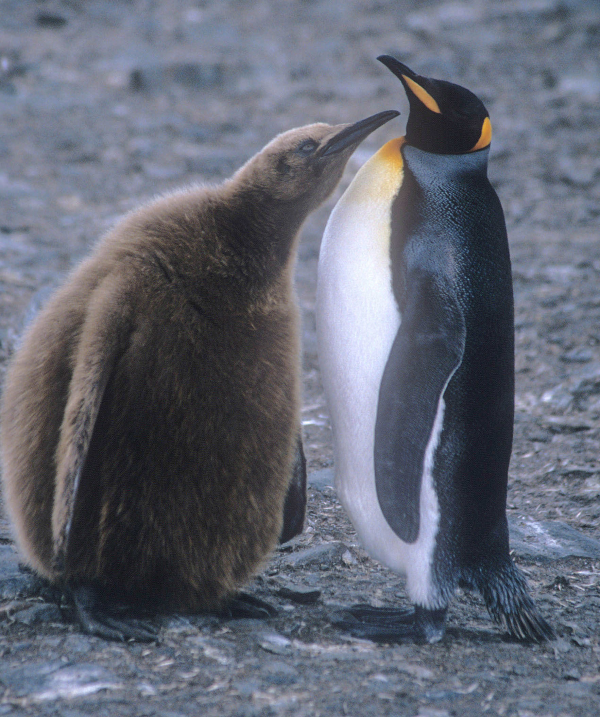
“Kings of the Beach” is the title of this photo of King Penguins pausing before entering the windblown surf on the shore of South Georgia Island.

A very small portion of the nesting colony at St. Andrews Bay that numbers an estimated half-million King Penguins.

The tight spacing of incubating King Penguins keeps thrusting bills just far enough apart to avoid contact. Each incubating penguin holds a single egg balanced on top of its feet and covered by a fold of skin.

A begging juvenile appears to overwhelm the adult, which has returned to feed its oversized offspring.
|
I predicted this would be the best morning of our entire journey, but there was no way of imagining the level of excitement and wonder that the wildlife on the shore of St. Andrews Bay would provide. On the east side of remote South Georgia Island, the sights and sounds of a half-million King Penguins thrilled my senses. This was truly a monumental experience! For more than a mile, King Penguins lined the beach and filled the shore leading inland to the edge of massive glaciers, spawned from steep, snow-covered mountain peaks that resembled the Alps – this scene was Amazing!
King Penguins are really something special. They are the second largest of the 17 species of penguins in the world – standing three feet tall – and they are the most colorful of all penguins, highlighted by vibrant orange plumage on their throat, nape, and bill. Each individual is amazing in itself, and the masses of King Penguins within my sight were absolutely magnificent!
King Penguins stood along the high-tide line, waded into the surf or swam in flocks in the glacier-blue water of the bay. As some Kings entered the water, other flocks rode the surf onto the black-sand beach to make landfall after feeding on squid and krill at sea. Some parts of the expanse before them were covered wing-tip to wing-tip by King Penguins, and thousands stood within every few square yards of land.
The returning adults walked ashore with deliberate steps as they passed territorial Antarctic Fur Seals and huddled groups of Southern Elephant Seals on their way inland. They passed throngs of molting Kings, with a few molting Giant Petrels resting nearby. Southern Skuas, Kelp Gulls, and Antarctic Terns flew overhead, and Snowy Sheathbills hustled through the hordes of penguins, adding some variety to the birds in this bustling scene. I even sighted one of the endemic ducks flying nearby, a South Georgia Pintail.
The King Penguins marched on along the edge of a mass of evenly spaced incubating adults, each balancing one huge white egg on top of its warm feet and under the cover of a fold of belly skin. When one bird in the returning flock decided to press forward between incubating birds the nesting colony immediately transformed into a gauntlet of sharp thrusting bills as the territorial penguins showed their displeasure with the passing intruder.
When the interloper reached its incubating mate, the pair stretched their necks upward and called in unison while waving their wings over their back. The piercing jabs of neighboring penguins continued as the male tried to fit into the cramped space of the nesting territory. Even so, the female was hesitant to pass the precious egg to its mate so it could begin its own feeding trip offshore.
Other penguins in the returning flock continued working their way inland, walking steadily uphill past thousands of other Kings until they were greeted by a crèche of huge brown off-spring, now 12 months old and weighing even more than the adults returning to feed them. The big juveniles were covered with long brown down that gives them a fluffy, furry look. They truly don’t resemble the adults, except perhaps their feet.
Within the group, a single juvenile penguin pursued each returning adult, calling incessantly to be fed, even though it looked as if it had been overfed time and time again. I watched one adult in particular that seemed to be uninterested in the fussing brown animal shadowing it, but it was actually leading the juvenile away from the other penguins. Eventually, the adult halted its follow-the-leader trek and waited for the oafish-looking juvenile to catch up. The young penguin aggressively grabbed at the adult’s bill, an action that eventually was rewarded with a mouthful of krill. The pink mass of shrimp-like food was barely swallowed before the oversized juvenile resumed incessantly calling for more.
I was happy to share this penguin experience with the other 40 passengers and crew of the small Russian cruise ship that morning on the shore of remote South Georgia Island in the South Atlantic far east of the coast of the southern tip of Argentina. As the passengers interacted on that sunny day, we all walked a little taller, maybe even floating a bit off the ground. When we met as a group along the edge of the nesting colony, we smiled lavishly and shared such phrases as, “Isn’t this unbelievable?” “What an experience!” and “Aren’t they amazing?”
I wish I could share the experience fully with people who have never seen penguins in the wild. To be immersed in the midst of so many King Penguins in this scenic location provided me with an exuberant feeling that transcended birding or wildlife photography. This quest was now a meaningful part of my life experiences.
Article and photographs by Paul Konrad
Share your birding experiences and photos at editorstbw2@gmail.com